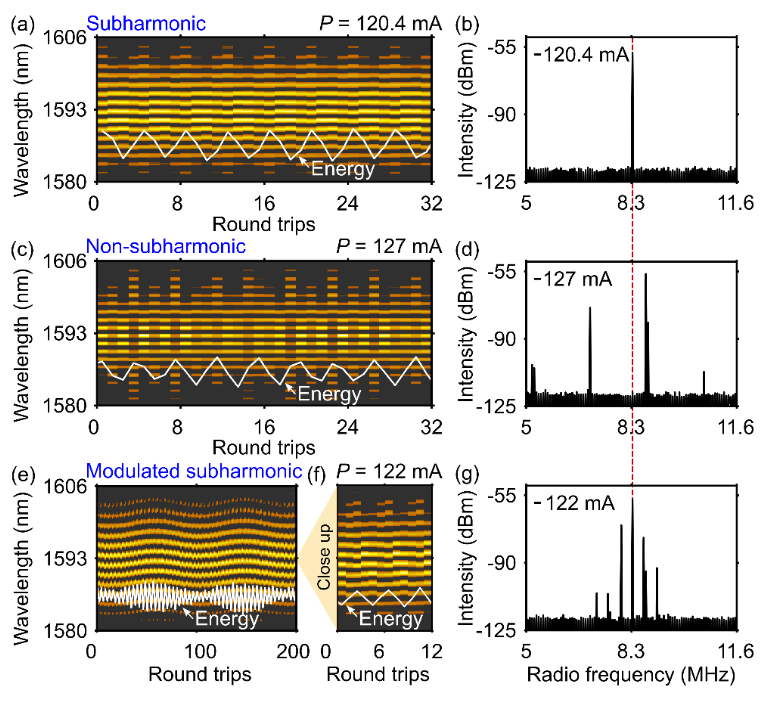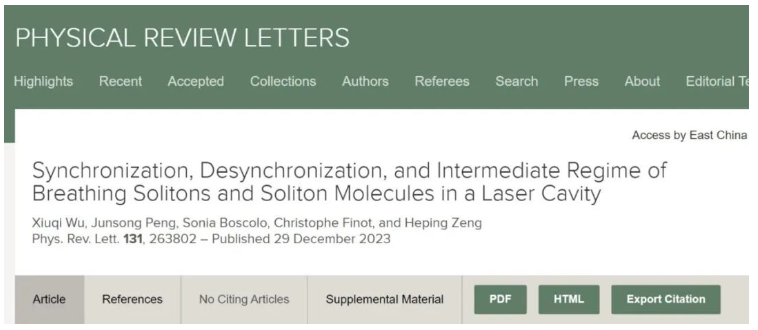Synchronicity refers to the consistency of the behaviors of multiple independent individuals. Synchronic phenomena widely exist in nature, such as crickets "singing" synchronously, a group of fireflies flashing together in the dark, and the ancient poem "work at sunrise and rest at sunset" also implies the phenomenon of synchrony, that is, human activities and the earth's rotation cycle be consistent. Scientists' research on synchronization phenomena can be traced back to 1665. Dutch physicist Huygens first discovered in an experiment that when a pair of pendulums were hung side by side on the wall, the swing periods of the two pendulums were slightly different at first. After a period of time, the swing periods of the two will eventually converge.
Usually, studying synchronization phenomena requires multiple resonators with similar parameters, which brings great difficulties to experimental research. For example, when studying the synchronization of two lasers, the difference in cavity length of the two lasers needs to be strictly controlled at the micron level or even smaller, and electronic assistance technology is required to achieve this precise control. If you want to study the synchronization of three or more resonators, the system will be more complex and the experimental difficulty will increase exponentially. Although multi-body synchronization dynamics is an important research content in nonlinear science, due to limitations of the experimental platform, most research is limited to two resonators, and multi-body synchronization research is relatively limited.
Recently, the team of Professor Zeng Heping of East China Normal University proposed and confirmed that multi-body synchronized dynamics can be studied within a single breathing soliton femtosecond laser. What's special about this laser is that it can output ultrashort pulses called breathing solitons. The energy of the output pulses of ordinary ultrashort pulse lasers is the same (soliton), while the energy of the output pulses of breathing solitons lasers changes with time and has a certain periodicity. A natural synchronization system is formed between this periodicity (breathing frequency) and the cavity frequency of the laser (determined by the laser cavity length). In addition, controlling the dissipation, nonlinearity and other parameters of the laser can generate a third frequency. Therefore, breathing solitons lasers provide the possibility to study multi-body synchronization dynamics.

Figure 1: Subharmonic spectrum (a) and radio spectrum signal (b); non-subharmonic spectrum (c) and radio spectrum signal (d); modulated subharmonic spectrum (e) and radio spectrum signal (g), Where (f) is an enlarged view of (e). The white lines in the figure represent energy, and the energy evolution of pulses in the three states is also very different.
This work reveals two types of multibody synchronization dynamics. First, the interaction between the three frequencies can produce a modulated subharmonic state that is a hybrid state between synchronization and desynchronization. When synchronized, the breathing solitons output by the laser belong to a subharmonic state (the breathing frequency is strictly equal to a fractional multiple of the cavity frequency, subharmonic), and the periodicity of spectral evolution is obvious (Figure 1a). The radio frequency signal shows this period more clearly. signal (Figure 1b); when desynchronizing, the periodicity is destroyed (Figure 1c), and the RF signal also deviates from the original sub-harmonic position (Figure 1d). The intermediate state between synchronization and desynchronization is shown in Figure 1e. At this time, the original subharmonic state (see enlarged Figure 1f for details) is modulated by the third frequency, so it is called modulated subharmonic. In addition to subharmonic signals, sidebands also appear in RF signals (Figure 1g).
Second, this work also reveals the delayed synchronization phenomenon of multiple breathing solitons. In the subharmonic state, multiple breathers are not only synchronized with each other, but also the entire wave packet (considering multiple breathing solitons as a whole) and the laser cavity are also synchronized. Interestingly, when the entire wave packet and the cavity are out of synchronization (Figure 1c, d), the multiple breathing solitons inside the wave packet are actually synchronized, but there is a phase difference between the breathing solitons at this time, so this phenomenon Known as delayed synchronization.
Finally, this work also demonstrates the stability of multi-body synchronization. As the number of breathing solitons increases, the system becomes more stable, that is, the synchronization interval is larger.
There are multiple physical effects in femtosecond lasers, including gain, dissipation, nonlinearity, dispersion, etc., so the dynamics are very complex. Clarifying its complex dynamics and mechanisms is a difficult issue in the laser field. Starting from the perspective of synchronization dynamics, this work not only reveals the relevant complex dynamics and mechanisms of femtosecond lasers, but also injects new kinetic energy into the important nonlinear science of synchronization. First, this work shows that only a single breathing soliton laser can be used to study multi-body synchronized dynamics. This simple and convenient system will greatly facilitate the study of multi-body dynamics. Secondly, the new multi-body dynamics phenomena revealed in this work, including modulated subharmonics, delayed synchronization and multi-body synchronization stability, lay the foundation for further research on multi-body synchronization dynamics. This work will also promote the study of multi-body synchronization dynamics in other physical systems. For example, breathing solitons phenomena also exist in systems such as microcavities, fluid mechanics, and cold atoms. There is reason to believe that these systems also have corresponding multi-body synchronized dynamic characteristics.

Physical Review Letters publishes the research results of team of professor Zeng Heping
The relevant results were published in Physical Review Letters on December 29, 2023 under the title "Synchronization, Desynchronization, and Intermediate Regime of Breathing Solitons and Soliton Molecules in a Laser Cavity". The first author of the paper is postdoctoral fellow Wu Xiuqi, and Professor Zeng Heping and Researcher Peng Junsong are the co-corresponding authors. Dr.Sonia Boscolo from Aston University in the UK and Professor Christophe Finot from the University of Burgundy in France are co-authors. This work was funded by the National Natural Science Foundation of China, Shanghai Municipal Science and Technology Commission, Chongqing Municipal Science and Technology Commission, and China Postdoctoral Science Foundation.
In recent years, the team has done systematic work in the field of breathing solitons ultrafast lasers, and proposed and confirmed breathing solitons ultrafast lasers, including continuous breathing solitons (Sci.Adv.5 eaax1110 2019) and discrete breathing solitons (Phys.Rev. Appl.11 044068 2019); revealed breathing solitons explosion dynamics (Phys. Rev. Appl. 12 034052 2019), many-body interactions (Laser & Photon. Rev. 2000132 2021) and breathing solitons fractal dynamics (Nat. Commun . 13, 5784 2022); using AI technology to realize intelligent control of breathing solitons lasers (Laser & Photon. Rev. 2100191 2021), etc.
